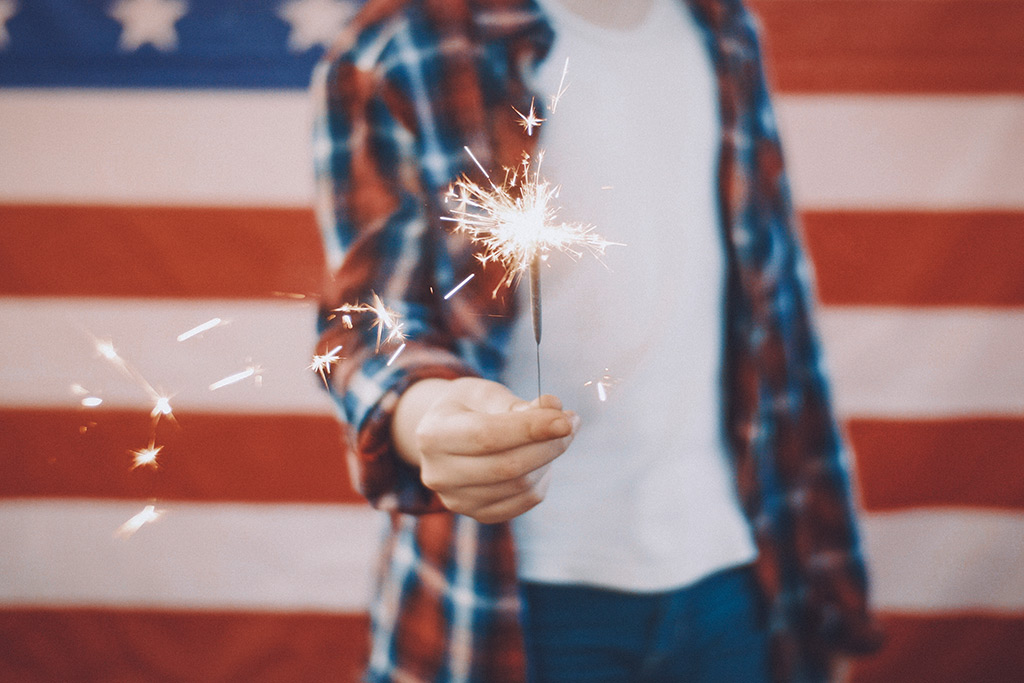As we roll through June and approach the month of July, it’s crucial to remember that it’s not only time for summer fun and Fourth of July festivities but also time to prioritize fireworks eye safety due to the high risk for eye injuries associated with fireworks celebrations.
In the month and days leading up to July 4th, two national organizations are raising awareness about the potential for eye injuries during the holiday. The American Academy of Ophthalmology, a professional medical association of ophthalmologists, has declared June as Fireworks Eye Safety Month, and Prevent Blindness, a nonprofit eye health and safety organization, has declared June 28-July 4 as Fireworks Safety Awareness Week.
Every year, thousands of people visit emergency rooms due to fireworks accidents. Many of those trips are due to eye injuries, making it essential to prioritize eye safety during these festivities.
Don’t sweat over poor vision this summer.
Schedule your FREE OKC LASIK consultation at nJoy Vision!Or call
(405) 842-6060
A Rich History of Risk and Wonder
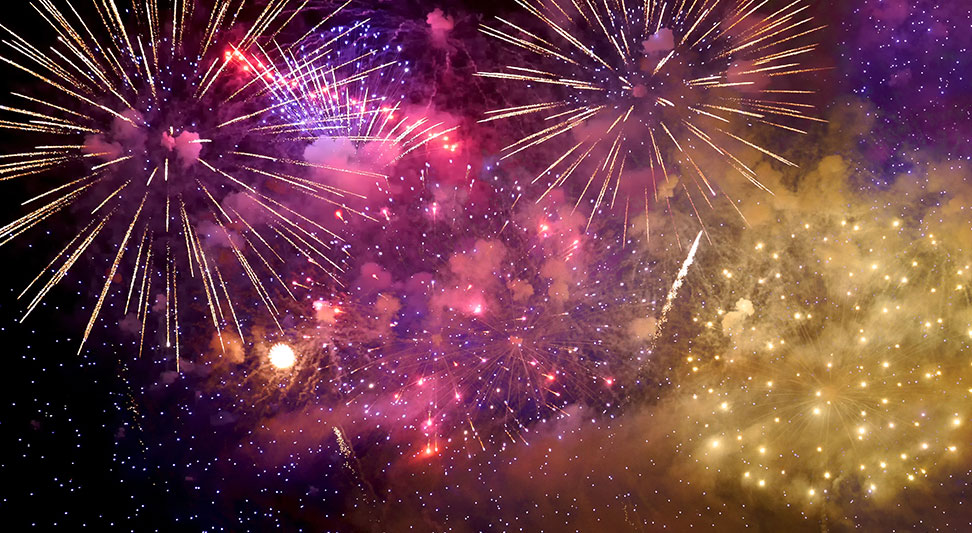
Fireworks are undeniably captivating and often create dazzling displays in the night sky.
However, they can pose serious risks to our eyes.
According to a 2023 report by the Consumer Product Safety Commission, 19% of all fireworks-related injuries in 2023 were eye injuries. These injuries included corneal abrasions, chemical and thermal burns, and retinal detachment – all of which can lead to permanent damage and vision loss.
Despite the dangers, fireworks have been used for centuries to celebrate various events and festivals around the world.
The Origins of Fireworks
The origins of fireworks can be traced back to ancient China, where gunpowder was invented around 2,000 years ago. Initially, gunpowder was used for medicinal and mystical purposes. However, people soon discovered its explosive properties and began using it for entertainment during celebrations and religious ceremonies. These early fireworks consisted of simple bamboo tubes filled with gunpowder that produced a loud bang and bright flashes when ignited.
Spread to the West
The use of fireworks gradually spread to the Arab world and Europe through trade routes. In Europe, fireworks gained popularity during the Renaissance period and became a symbol of grandeur and celebration among nobility. Elaborate fireworks displays were showcased during royal weddings, coronations, and other significant events.
Fireworks in America
Fireworks arrived in America with the English colonists in the 17th century. Early American colonists used fireworks to commemorate important events, such as the arrival of a new governor or a religious festival. However, it wasn’t until the first anniversary of the Declaration of Independence on July 4, 1777, that fireworks gained prominence in America.
A 4th of July Tradition
The 4th of July, also known as Independence Day, commemorates the ratification of the Declaration of Independence by the Second Continental Congress in 1776, declaring the 13 American colonies as a new nation separate from British rule. The early celebrations of Independence Day often involved speeches, parades, bonfires, and the firing of cannons and muskets. Over time, fireworks became an integral part of the festivities, symbolizing the spirit of freedom and patriotism.
Modern Fireworks Displays
Today, fireworks displays on the 4th of July have become a cherished tradition across the United States. These displays feature breathtaking pyrotechnics, including colorful explosions, glittering cascades, and mesmerizing patterns synchronized to music. They serve as a grand finale to Independence Day celebrations, bringing communities together to marvel at the spectacle and express their national pride.
Tips for Fireworks Eye Safety
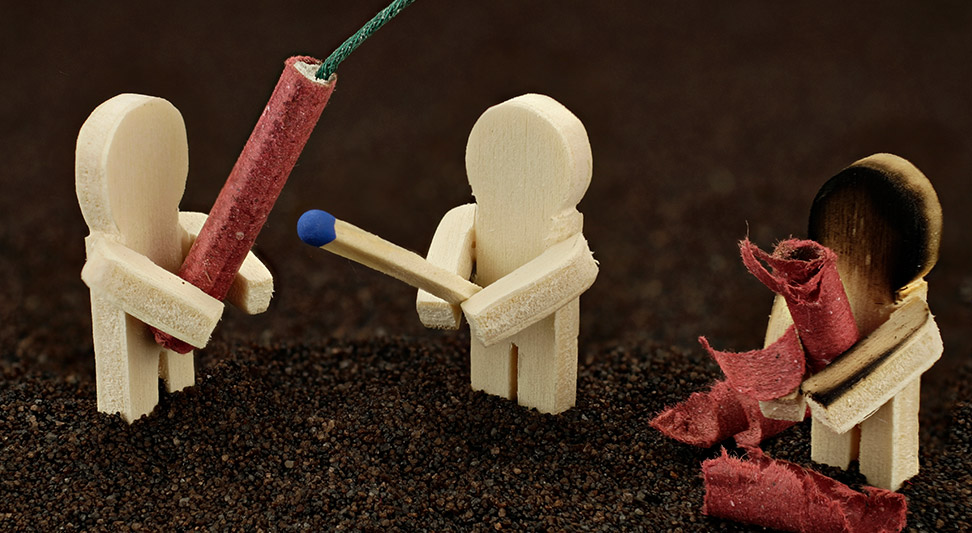
It’s important to remember that while fireworks are an integral part of July 4th festivities, safety should always be a top priority.
Attend Public Displays
Consider enjoying professional fireworks displays organized by experts. These displays offer a safer alternative to personal fireworks use while still providing an exciting and memorable experience.
Leave it to the Professionals
Avoid handling fireworks yourself, as they require specialized training and expertise. Fireworks are best left in the hands of professionals who have the necessary knowledge to ensure safety.
Wear Protective Eyewear
If you do handle fireworks, make sure to wear protective eyewear such as safety glasses or goggles specifically designed to shield your eyes from potential debris or sparks.
Keep a Safe Distance
Maintain a safe distance from fireworks when they are being ignited. Follow the recommended viewing distance specified by the event organizers to minimize the risk of eye injuries.
Stay Vigilant
Be aware of your surroundings and keep an eye out for children or others who may be in close proximity to fireworks. Remain cautious even after fireworks have been ignited, as sometimes they can malfunction or have delayed reactions.
Follow Instructions
If you choose to use consumer fireworks, carefully read and adhere to all instructions and warnings on the packaging. Use them in designated outdoor areas, away from flammable materials.
First Aid and Emergency Plan
Prepare a first aid kit that includes sterile eye wash solution and sterile gauze pads. Additionally, have a plan in place for emergencies and know how to seek immediate medical attention in case of an eye injury.
In Case of an Eye Injury
If an eye injury occurs, acting swiftly and seeking professional medical help is essential.
Remember these important steps:
- Do not rub or apply pressure to the injured eye.
- Do not attempt to remove any foreign objects stuck in the eye.
- Place a protective shield, like a paper cup, over the injured eye to prevent further damage.
- Seek immediate medical attention from an eye doctor or visit the nearest emergency room.
If you don’t have an eye doctor, you can find an nJoy Vision preferred eye doctor in your area.
Consumer Fireworks Guidelines
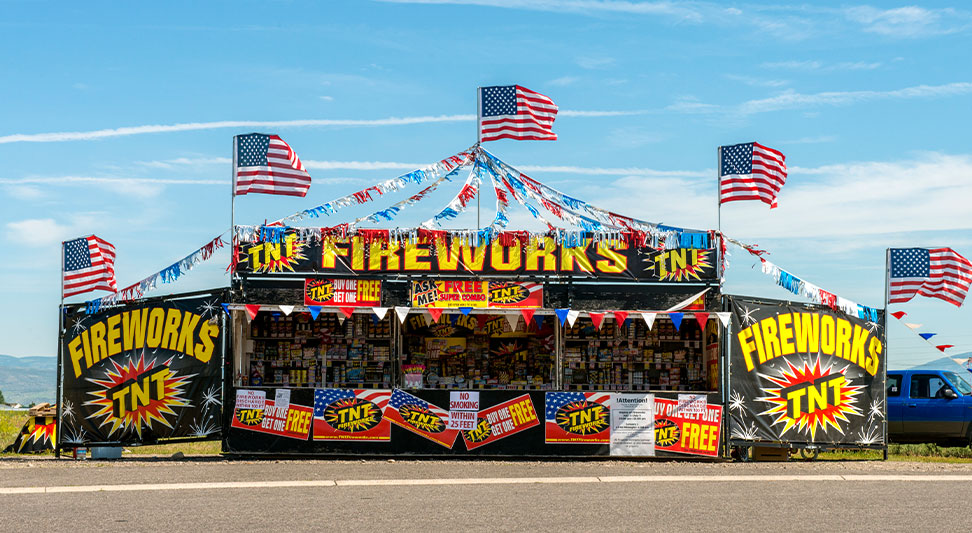
When celebrating Independence Day, it’s best to leave the explosives to the professionals. However, consumer fireworks are a huge part of the July 4th experience. So, if you’re going to end up with firecrackers, sparklers, bottle rockets, and Roman candles in your hands, here are some things to keep in mind before you start lighting fuses.
Make Quality a Priority
When it comes to assessing the quality of fireworks, there are a few factors you can consider. Here are some ways to help determine if fireworks are of good quality:
- Purchase from Reputable Sellers. Buy fireworks from established and reputable sellers. Look for vendors with a track record of providing high-quality products and who follow safety standards and regulations.
- Check for Legitimate Labels and Certifications. Look for fireworks that carry appropriate labels and certifications. In the United States, look for fireworks that meet the standards set by the Consumer Product Safety Commission (CPSC) and are approved by the American Fireworks Standards Laboratory (AFSL). These certifications indicate that the fireworks have undergone testing and meet specific safety requirements.
- Reliable Brands. Choose fireworks from well-known and trusted brands. Established fireworks manufacturers tend to have a reputation for producing reliable and high-quality products. Research and read reviews to identify brands with positive feedback and a history of delivering good fireworks.
- Packaging and Condition. Examine the packaging of the fireworks. Look for clear and professional labeling, including safety instructions, usage guidelines, and manufacturer information. Check that the packaging is intact and shows no signs of tampering or damage. Damaged packaging could be an indication of mishandling or poor storage conditions.
- Performance and Effects. While you may not be able to assess the performance of fireworks before purchasing them, you can look for information or reviews on the specific types or brands of fireworks you are considering. Pay attention to the reported performance, such as the intensity of colors, duration of the effects, and overall visual appeal. Reliable brands often produce fireworks that deliver impressive displays.
- Compliance with Local Laws. Ensure that the fireworks you are purchasing comply with local laws and regulations. Different regions have varying restrictions on the types and sizes of fireworks allowed. Buying fireworks that adhere to local regulations helps ensure both safety and legality.
Don’t Light Last Year’s Fireworks
The safety and performance of fireworks can deteriorate over time, especially if they aren’t stored properly. To ensure a safe and enjoyable fireworks experience, purchasing new fireworks from reputable sellers each year is recommended. If you have unused fireworks from previous years, it is best to dispose of them properly according to local guidelines or seek advice from local authorities on safe disposal methods.
Here are some reasons why it’s not safe to use expired or leftover fireworks:
- Instability. Fireworks are made up of chemicals and explosive materials. Over time, these materials can degrade, leading to instability. Expired fireworks may become unpredictable, increasing the risk of malfunction or unexpected behavior when ignited.
- Reduced Effectiveness. The quality and performance of fireworks diminish over time. The colors may fade, the effects may weaken, or the fireworks may not ignite or launch as intended. This can result in disappointing displays or situations where the fireworks don’t function properly, potentially leading to accidents.
- Deterioration and Damage. Improper storage conditions can further degrade fireworks. Exposure to moisture, heat, or extreme temperature fluctuations can cause the chemicals to deteriorate, affecting their reliability and safety. Damaged fireworks, such as those with torn or compromised packaging, should never be used.
- Safety Risks. Using expired or damaged fireworks increases the risk of accidents and injuries. They may not ignite correctly, explode prematurely, or release debris unpredictably. It’s crucial to prioritize safety and minimize potential risks by using only fresh and reliable fireworks.
Handle With Extra Care
Fireworks can vary in terms of safety based on their design, construction, and the level of caution exercised while handling and using them. It’s important to note that even the seemingly safer fireworks can cause injuries if used irresponsibly or without proper precautions. However, certain types of fireworks have been historically associated with higher risks.
Here is a general overview of the relative safety levels of five common types of fireworks:
- Firecrackers. Firecrackers, especially those with larger explosive charges, are known to be more dangerous if mishandled. They are typically small in size and produce loud bangs when ignited. Firecrackers can cause injuries if held or thrown inappropriately or explode near people or objects.
- Bottle Rockets and Rockets. Bottle rockets and rockets are launched into the air and can travel a significant distance. While they provide an impressive display, they carry risks if not handled properly. Accidental misfires or improper launch angles can cause them to fly unpredictably, potentially leading to injuries or property damage.
- Roman Candles. Roman candles are long tubes that shoot out multiple colored balls or stars. They can be relatively safe if used responsibly, with the tube securely placed in the ground or in a suitable holder. However, mishandling, aiming at people or flammable materials, or using damaged Roman candles can lead to accidents.
- Fountains and Sparklers. Fountains and sparklers are generally considered among the safer types of fireworks when used with caution. Fountains emit sparks and colorful effects from a stationary position, while sparklers are handheld rods that produce sparks when lit. However, both can still pose risks if mishandled or misused, especially if brought close to the body or used by unsupervised children.
- Homemade or Illegal Fireworks. Homemade or illegally manufactured fireworks are extremely unsafe. They are often produced without quality control measures or adherence to safety standards, increasing the risk of malfunction, unpredictable explosions, and injury. Avoid these fireworks due to their high potential for danger.
Fireworks Displays In and Around the Oklahoma City Metro
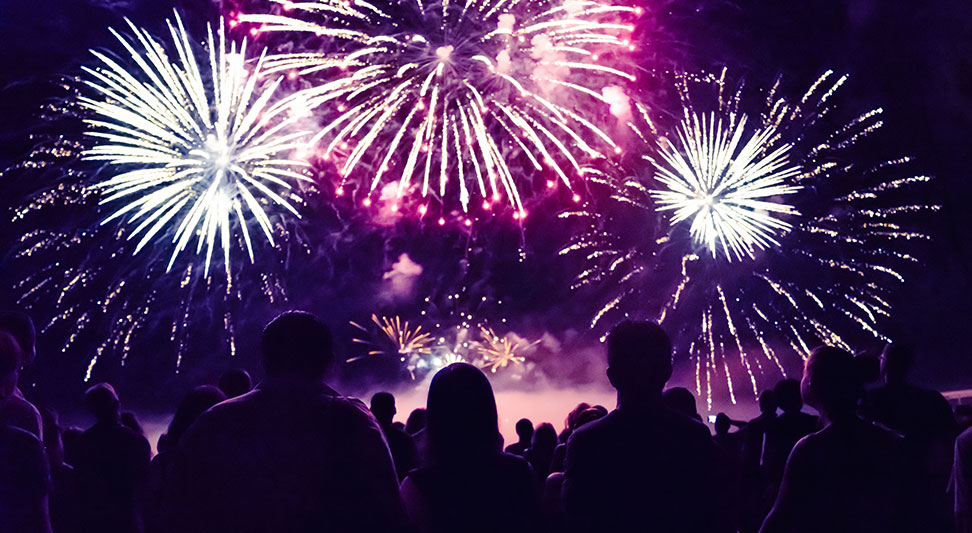
Event details are subject to change, so checking each event’s page or website for complete details and times is advisable.
June 28
- Purcell Independence Day Celebration at Purcell City Lake (1400 Chandler Rd, Purcell). 5-10pm (fireworks at 9:45pm). FREE
- Bixby Freedom Celebration at the Bentley Park Sports Complex (8505 E 148th St S, Bixby). 7-10pm (fireworks at 9:45pm). FREE
June 29
- Mustang Firefighters Freedom Celebration at Wild Horse Park (1201 N Mustang Rd, Mustang). 6:30-10:30pm. FREE
- Liberty Fireworks Bash in Nicoma Park (2540 Liberty Blvd, Nicoma Park). Noon-10:45pm (fireworks at 10pm). FREE until 6pm; $5/person after 6pm; Children 12u Free
June 30
- Freedom Fest at Community Church (512 E Seward Rd, Guthrie). 5-10pm. FREE
- Family Freedom Fest at The Bridge Church (1116 W State HWY 152, Mustang). 7-10pm (fireworks at sundown). FREE
July 4, 5 & 6
- 4th of July Celebration at Frontier City (11501 N I-35 Service Rd). Fireworks nightly at 9:00pm. Park admission is required.
July 2
- Blanchard’s Independence Celebration (10th & HWY 62, Blanchard). 6-10pm (fireworks at 10pm). FREE
July 3
- City of Tuttle Fireworks Show (Downtown Tuttle). 9pm. FREE
- Red, White & Boom (Scissortail Park) 8:30pm concert followed by fireworks. FREE
July 3 & 4
- Yukon Freedom Fest at Chisholm Trail Park (500 W Vandament, Yukon) & Yukon City Park (2200 S Holly, Yukon). July 3 – 5-10pm (fireworks at 10pm); July 4 – 8am-10pm (fireworks at 10pm). FREE
July 4
- Bethany Boom at Eldon Lyon Park (7400 NW 36th St.) 10am-10pm (fireworks at 9:55pm). FREE
- Choctaw 4th of July Celebration at Choctaw Creek Park (2001 N Harper Rd, Choctaw). 50pm (fireworks at dusk). FREE
- Edmond LibertyFest Fireworks at Hafer Park (1034 S. Bryant). 9:30pm. FREE
- Moore’s Celebration in the Heartland at Buck Thomas Park (1903 NE 12th St, Moore). 2pm-10pm (fireworks at 9:45pm). FREE
- Norman Fourth Fest at Reaves Park (2501 Jenkins Ave, Norman). 5-10pm (fireworks at 9:45pm). FREE
- Midwest City Tribute to Liberty at Joe B. Barnes Regional Park (8700 E Reno Ave, Midwest City). 7-10pm (fireworks at 9:45pm). FREE
- Piedmont Freedom Fest on Piedmont Road (713 N Piedmont Rd, Piedmont). 5pm-Dark (fireworks at dusk). FREE
July 4, 5 & 6
4th of July Celebration at Frontier City (11501 N I-35 Service Rd). Fireworks nightly at 9:00pm. Park admission is required.
The Grand Finale

As we embrace the spirit of celebration this July 4th, let’s prioritize our eyes’ safety and remember that safeguarding our vision is an essential part of enjoying the festivities. By being aware of the risks associated with fireworks, following safety guidelines, and enjoying public displays, we can ensure a memorable and injury-free Independence Day.

